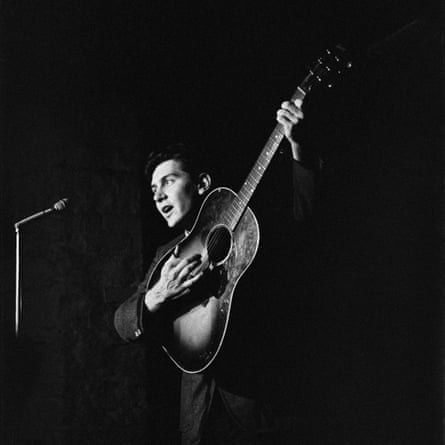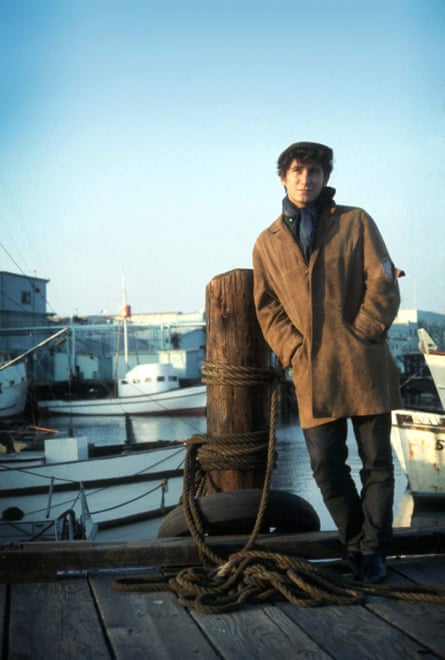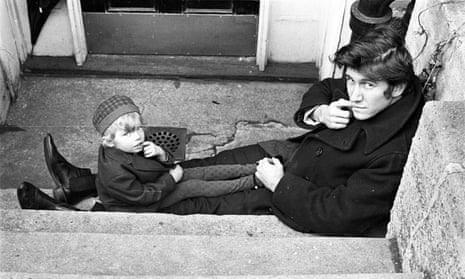As a kid in the 1950s, Phil Ochs cut class and spent afternoons at the local movie house. The Searchers and Rebel Without a Cause were two of his favourites. Always a dreamer, Ochs fantasised that one day he could be a stoic cowboy like John Wayne, a teenage rebel like James Dean, or a rockabilly sex symbol like Elvis Presley. He took his early love of Hollywood with him to New York, where he became one of the most celebrated folk singers in the world, culminating in an album that has just turned 50: Greatest Hits, titled with a savage, knowing irony.
Ochs came up in the Greenwich Village folk scene, rattling off songs at a pace that caused Bob Dylan – with whom he had a friendly rivalry – to complain “I just can’t keep up with Phil”. But Ochs couldn’t cross over like Dylan did. His sole hit song There But for Fortune, which reached No 50 in the US and the Top 10 in the UK, was performed by Joan Baez.

The peak of his career took a different form. In 1968, aged 27, Ochs agreed to help organise and perform at the Festival of Life demonstration against the Vietnam war in Chicago’s Grant Park, at the Democratic National Convention. During his performance of I Ain’t Marching Anymore, one of his most acerbic and damning anti-war songs, bursts of fire sparkled throughout the crowd as young men from across America took the song’s message to heart and burned their draft cards. It was a defining moment in Ochs’s life and one of his greatest personal achievements. “This is the highlight of my career,” he told journalist Paul Krassner as he walked off stage. He felt like a Hollywood hero.
His sense of triumph would not last long. In the days following Ochs’s performance, Chicago mayor Richard Daley dispatched hundreds of police officers into Grant Park, sparking mass violence and leaving many demonstrators and police severely injured. Hubert Humphrey, the establishment candidate, won the nomination. Richard Nixon won the election. To many, the dream of the 60s died that summer in Chicago, but Ochs took the defeat especially hard.
Unknown to most of the music industry and his fans, Ochs battled undiagnosed and untreated bipolar disorder. When the revolution that first inspired him to write and sing apparently shattered, Ochs felt he no longer had an artistic or political purpose. He entered into the deepest, darkest depression of his life. By 1969, he was drinking heavily and abusing prescription drugs, worrying his friends and family. He’d recently separated from his wife Alice, with whom he had a young daughter, Meegan, and relocated from New York to Los Angeles with a new girlfriend. In LA, Ochs spent his days and nights listlessly reading the newspaper, watching TV and drinking at the legendary Troubadour nightclub. His once bountiful stream of creative energy trickled to almost nothing.
Enter Elvis Presley. Michael Ochs, Phil’s brother and manager, scored tickets to Elvis’s comeback performance in Las Vegas and took Phil to the gig. By this point, Elvis was overweight and deeply into his polyester jumpsuit period, but Ochs was stunned by the King’s electrifying performance. He had an idea.

Ochs concluded that Nixon had won because he had a more direct connection to the American people, and was determined to alleviate the drugs, violence, and lawlessness that the counterculture now represented. The old folkie Phil Ochs image served no purpose in modern America, he thought. If he had anything left to say, artistically or politically, he needed to meet America on America’s terms. In Ochs’s own words, “getting Elvis Presley to become Che Guevara”.
Back in LA, he got to work on what would become his sixth and final studio album, Greatest Hits. It’s his most singularly cohesive and confounding work – an experimental country rock album steeped in bleak postmodern Americana. Each song takes the listener on a vivid, hazy and often disturbing trip through Ochs’s mid-century American dream: visions of idyllic movie houses and open highways give way to dead movie stars, alcoholism and Hollywood excess.
Every aspect of the record, including the title, was contrary to the earnest folk singer image that Ochs was known for. Against the advice of his label, his manager, and pretty much everyone else in his life, Ochs insisted on titling the album Greatest Hits: a self-effacing joke considering he virtually had no hits to speak of. Greatest Hits was almost guaranteed to cause confusion among his fans, who might buy the album thinking they were going to get Phil Ochs classics, only to be confronted with not only new songs, but a drastic shift in musical style. As of today, Apple Music mistakenly lists Greatest Hits as a hits compilation, not a studio album of new material.

Ochs hired Nudie Cohn, a designer of exquisitely gaudy, rhinestone outfits for Elvis and Gram Parsons, to make him a new suit that would be his official uniform for the new album. But not just any new suit – a gold lamé suit, similar to the one Elvis famously wore on the cover of his greatest hits compilation 50,000,000 Elvis Fans Can’t Be Wrong. On the Greatest Hits cover, Ochs appears slightly dwarfed and uncomfortable, not the confident, cocky young activist we see on the sleeve of I Ain’t Marching Anymore. On the back, he poses below the words 50 Phil Ochs Fans Can’t Be Wrong! Ochs had always been a prankster, but his label was flabbergasted by the sardonic, self-sabotaging concept of his new album.
The recording of Greatest Hits, produced primarily by Van Dyke Parks, took only two days, likely due to budget restrictions – Ochs was far from a bestseller for A&M Records and they were understandably doubtful of the record’s commercial potential. Parks described Ochs as “intense” during the sessions. They hired highly regarded studio musicians, including Elvis guitarist James Burton, Ry Cooder, and Merle Haggard backup singer Bobby Wayne. Ochs often played with the band in the same room, a technique used on country records to add a looser honky-tonk vibe to the songs. The opening track, One Way Ticket Home, explodes in bombastic Technicolor with horns, timpani and rockabilly guitars – equal parts Ennio Morricone and Elvis. On Boy in Ohio, Ochs’s lovely ode to the simplicity of his youth, Parks pulls the instrumentation back to a simple slide guitar and harmonica punctuating delicate acoustic strumming and a tender vocal.
On that song, Ochs remembers the thrill of early discovery in a picture-perfect midwestern town, lamenting the unrelenting speed of American progress: “We would wait for the summer to come / For swimmin’ and pickin’ berries / But now a freeway covers the field / Where I used to be so happy”. Jim Dean of Indiana is the heart of Greatest Hits and even more wrenching: a devastating, masterfully told tribute to James Dean, Ochs’s ultimate movie hero. Ochs paints the rise and fall of Dean – “he played a boy without a home, torn with no tomorrow” – through the eyes of an adoring fan, in the final stanza revealed to be Ochs himself. Drawing subtle parallels between Dean’s rise to fame and his own, Ochs questions the psychological toll of stardom and the cult of personality surrounding dead celebrities.
One gets the sense that Ochs had already, on some level, made peace with the death of his career, and Chords of Fame scarily predicts the swift slide into alcoholism and madness that the 70s held in store for him: “God help the troubadour who tries to be a star.” Basket in the Pool describes a real incident where a wasted Ochs won a basket filled with fine wine and cheeses as a door prize at comedian Tom Smothers’ party – Ochs thought it would be funny to throw the basket of goodies into the pool, which disgusted the other guests. Gas Station Women describes a brokenhearted factory worker, but minus the factory; the song could be a description of Ochs’s life after the disaster of Chicago. On the closing track, No More Songs, the refrain reads:
Hello hello hello, is anybody home
I’ve only called to say I’m sorry
The drums are in the dawn
And all the voices gone
And it seems that there are no more songs
Greatest Hits sold less than 50,000 copies and remains the poorest selling album of Ochs’s career. It was pulled from shelves weeks after its release. Still, Ochs was determined to fight for his vision of American popular music as a vehicle for a socialist revolution. He took his gold lamé suit and performed two raucous shows at Carnegie Hall, featuring medleys of Elvis and Buddy Holly tunes and almost none of his old folk classics. He was mostly booed. A live recording of these shows was released in 1974 under the title Gunfight at Carnegie Hall. “Bring back Phil Ochs!” an audience member shouts. By the end of the Greatest Hits tour debacle, Ochs was spent: creatively, physically, spiritually and politically.
By the early 70s, singer-songwriters largely turned apolitical and inward, which never suited Ochs. James Taylor’s Sweet Baby James, released in the same month as Greatest Hits, was a Top 10 hit and sold 3 million copies. Joni Mitchell was about to go Blue; Dylan had largely gone on hiatus. Having failed to endear himself to a new generation, Ochs occasionally worked on new songs, but he would never again assemble enough material for another studio album. He travelled around the world, played shows here and there, befriended revolutionaries, played backgammon, wrote movie reviews, and kept organising protests, rallies and benefits.
The songs on Greatest Hits always remained among his favourites – John Lennon, a longtime fan, once jammed with him on Chords of Fame. But Ochs was never able to recover from a manic, alcoholic bender in the summer of 1975, when he assumed an evil alter ego named John Butler Train, designed to kill off the old Phil Ochs for good. In the 2010 Ochs documentary There But for Fortune, Sonny Ochs, his sister, describes his final days in early 1976 at her house in Far Rockaway, New York. Broke and exhausted, he would sometimes sit at Sonny’s piano and pick out the mournful, sublime melody of Jim Dean of Indiana, possibly the last music he would ever play. He died by suicide.
History will rightly remember Phil Ochs for his topical protest songs, among the sharpest ever written in American folk music, and in Greatest Hits we’re able to see where the strength of his conviction came from. The boy in the movie house worshipping at the feet of James Dean, and America, a place he loved dearly and believed could be better, more humane and forgiving. In the days before his death, Ochs asked his brother Michael: “Do you think the songs will be remembered?” He needn’t have worried. His beloved and scorned gold lamé suit, meanwhile, hangs in the archive of that other great American protest singer: Woody Guthrie.

Comments (…)
Sign in or create your Guardian account to join the discussion